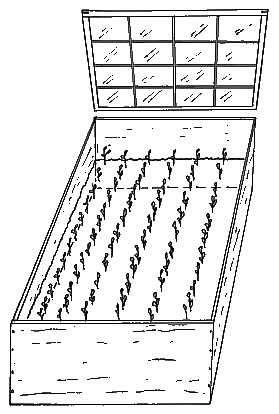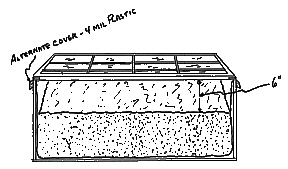QBARS - v25n2 Easy Way to Propagate Rhododendrons
An Easy Way to Propagate Rhododendrons
Bob Overstreet, Everett, Wn.
Want an EASY way to propagate many of your favorite rhododendrons? This method is easy. It is inexpensive because no heat other than that supplied by Mother Nature is used. There is no green house required. Only a small cold frame or plastic tent over a standard flat. It is particularly effective when used with the smaller lepidote types which can be hard to handle at the same time the larger elepidote types are being cut.
A unit is needed to hold the rooting media and the cuttings, and yet have enough air tightness to keep all the moisture contained within the unit itself. It can be a standard nursery flat, or a small cold frame as in the adjacent illustration. I will describe here my experience with a cold frame type. One inch by ten inch rough sawn cedar lumber was used for the sides. The approximate size was three feet by four feet, or the size required to fit under the two window panes I was using. If a window pane isn't available, some type of plastic covered frame will do. A restricted air space of less than six inches will probably be no drawback.
Location of the frame is most important, because much light is needed for rooting success and warmth. There should be heavy filtered shade especially during the hot afternoons.
Full shade is harmful to results. Move the empty frame around before starting to use it and observe the amount of sun it will get. A high air temperature of 65-75° is probable most desirable. A bush or large branch could be pulled into the proper place to make some shade. Remember that the arch the sun takes across the sky changes enormously between late June and September, so allow for this in your placement. No direct sun at any time , as the plastic or glass will intensify the sun's heat and all will be lost in a few short minutes. Light and the sun's heat are essential ingredients.
Having found the best location for the frame, you are ready to prepare it for cuttings. The entire inside is lined with 4 mil plastic. This is on the bottom, sides, and over the top edges. Be sure there are no holes or breaks in the plastic, as there is to be no drainage. The soil mix of 2/3 to 1/2 sand, perlite, or pumice and 1/3 to 1/2 peat moss is thoroughly mixed and dampened. It is very important that the soil be well watered but not waterlogged. Squeeze the mix in your hands to drain the excess water. The roof of the unit will sweat and drip to provide the high humidity required inside.
The best time to take cuttings is late June or early July depending upon the area, the progression of the growing season and the types of material to be cut. The wood to be cut should be fully elongated, the leaves fully grown, and the stem should snap readily when bent. Avoid soft, rubbery material. There should be enough firmness so the cutting will not wilt while being worked. Trim the foliage to 3 or so tip leaves, cut to the desirable length and wound the bark to the cambium layer as normally done.
Cuttings should not be over 3" above the soil and placed about 1" into the soil. In this last season I used Hormodine No. 3, or you might try Rootone powder. Insert the cuttings into the rooting media one inch apart in rows two inches apart. Firm cuttings in the rooting media with fingers after pushing in the cutting. After all the cuttings are inserted, water lightly and seal the unit.
Close the frame and forget about it until October or November. You might want to check the moisture every month or so. Done properly, success will be yours.
I tried this method with 100 rhododendrons and some evergreen shrubs this last summer. The rooting success of these hybrids and species is shown in the attached chart. Good roots were those needing no additional treatment, weak root were small and needed further development. I discovered that I had not wounded some of the stems, even so some still rooted. I am sure the success would have been greater if all the cuttings had been wounded.
Nearly all deciduous azaleas, conifers (except pines), many evergreen azaleas, and most deciduous plants, will root with this method.
| No. of Cuttings | Rooting |


|
|||
|---|---|---|---|---|---|
Good |
Poor |
None |
|||
Elepidote Hybrids: |
|||||
'Cynthia' |
4 |
3 |
1 |
||
'Christmas Cheer' |
5 |
2 |
2 |
1 |
|
'Jock' |
8 |
3 |
5 |
||
'Rosa Mundi' |
10 |
5 |
3 |
||
williamsianum cross |
6 |
4 |
1 |
||
Lepidote Hybrids: |
|||||
'Cream Crest' |
3 |
2 |
1 |
||
'Blue Bird' |
6 |
4 |
2 |
||
'Emasculum' |
6 |
5 |
1 |
||
'Finch', P.A. |
6 |
2 |
2 |
2 |
|
'Olive' |
6 |
4 |
2 |
||
'P.J.M.' |
6 |
4 |
1 |
1 |
|
'Racil' |
4 |
4 |
|||
'Russautinii' |
6 |
4 |
2 |
||
R. flavidum x 'Lady Rosebery' |
6 |
3 |
2 |
1 |
|
Lepidote Species: |
|||||
R. cinnabarinum var. purpurellum |
6 |
3 |
3 |
||
R. chasmanthum |
6 |
1 |
3 |
2 |
|
R. scintillans |
6 |
3 |
2 |
1 |
|
93% rooted |
|||||

